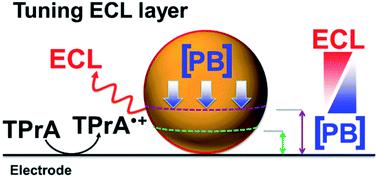当前位置:
X-MOL 学术
›
Chem. Sci.
›
论文详情
Our official English website, www.x-mol.net, welcomes your
feedback! (Note: you will need to create a separate account there.)
Spatially resolved electrochemiluminescence through a chemical lens
Chemical Science ( IF 7.6 ) Pub Date : 2020-09-14 , DOI: 10.1039/d0sc04210b Andrea Fiorani 1 , Dongni Han 2, 3 , Dechen Jiang 4 , Danjun Fang 3 , Francesco Paolucci 1 , Neso Sojic 2, 5 , Giovanni Valenti 1
Chemical Science ( IF 7.6 ) Pub Date : 2020-09-14 , DOI: 10.1039/d0sc04210b Andrea Fiorani 1 , Dongni Han 2, 3 , Dechen Jiang 4 , Danjun Fang 3 , Francesco Paolucci 1 , Neso Sojic 2, 5 , Giovanni Valenti 1
Affiliation

|
Electrochemiluminescence (ECL) microscopy is an emerging technique with a wide range of imaging applications and unique properties in terms of high spatial resolution, surface confinement and favourable signal-to-noise ratio. Despite its successful analytical applications, tuning the depth of field (i.e., thickness of the ECL-emitting layer) is a crucial issue. Indeed, the control of the thickness of this ECL region, which can be considered as an “evanescent” reaction layer, limits the development of cell microscopy as well as bioassays. Here we report an original strategy based on chemical lens effects to tune the ECL-emitting layer in the model [Ru(bpy)3]2+/tri-n-propylamine (TPrA) system. It consists of microbeads decorated with [Ru(bpy)3]2+ labels, classically used in bioassays, and TPrA as the sacrificial coreactant. In particular we exploit the buffer capacity of the solution to modify the rate of the reactions involved in the ECL generation. For the first time, a precise control of the ECL light distribution is demonstrated by mapping the luminescence reactivity at the level of single micrometric bead. The resulting ECL image is the luminescent signature of the concentration profiles of diffusing TPrA radicals, which define the ECL layer. Therefore, our findings provide insights into the ECL mechanism and open new avenues for ECL microscopy and bioassays. Indeed, the reported approach based on a chemical lens controls the spatial extension of the “evanescent” ECL-emitting layer and is conceptually similar to evanescent wave microscopy. Thus, it should allow the exploration and imaging of different heights in substrates or in cells.
中文翻译:

通过化学透镜空间分辨电化学发光
电化学发光(ECL)显微镜是一种新兴技术,具有广泛的成像应用和在高空间分辨率、表面限制和良好的信噪比方面的独特特性。尽管其分析应用取得了成功,但调节景深(即ECL 发射层的厚度)仍然是一个关键问题。事实上,ECL 区域(可被视为“消失”的反应层)厚度的控制限制了细胞显微镜和生物测定的发展。在这里,我们报告了一种基于化学透镜效应的原始策略,以调整 [Ru(bpy) 3 ] 2+ /三正丙胺(TPrA) 系统模型中的 ECL 发射层。它由装饰有 [Ru(bpy) 3 ] 2+标签的微珠组成,通常用于生物测定,并以 TPrA 作为牺牲共反应物。特别是,我们利用溶液的缓冲能力来改变 ECL 生成中涉及的反应速率。首次通过绘制单个微米珠水平的发光反应性来证明对 ECL 光分布的精确控制。所得 ECL 图像是扩散 TPrA 自由基浓度分布的发光特征,它定义了 ECL 层。因此,我们的研究结果提供了对 ECL 机制的见解,并为 ECL 显微镜和生物测定开辟了新的途径。事实上,所报道的基于化学透镜的方法控制“倏逝”ECL发射层的空间延伸,并且在概念上类似于倏逝波显微镜。因此,它应该允许对基底或细胞中的不同高度进行探索和成像。
更新日期:2020-10-07
中文翻译:

通过化学透镜空间分辨电化学发光
电化学发光(ECL)显微镜是一种新兴技术,具有广泛的成像应用和在高空间分辨率、表面限制和良好的信噪比方面的独特特性。尽管其分析应用取得了成功,但调节景深(即ECL 发射层的厚度)仍然是一个关键问题。事实上,ECL 区域(可被视为“消失”的反应层)厚度的控制限制了细胞显微镜和生物测定的发展。在这里,我们报告了一种基于化学透镜效应的原始策略,以调整 [Ru(bpy) 3 ] 2+ /三正丙胺(TPrA) 系统模型中的 ECL 发射层。它由装饰有 [Ru(bpy) 3 ] 2+标签的微珠组成,通常用于生物测定,并以 TPrA 作为牺牲共反应物。特别是,我们利用溶液的缓冲能力来改变 ECL 生成中涉及的反应速率。首次通过绘制单个微米珠水平的发光反应性来证明对 ECL 光分布的精确控制。所得 ECL 图像是扩散 TPrA 自由基浓度分布的发光特征,它定义了 ECL 层。因此,我们的研究结果提供了对 ECL 机制的见解,并为 ECL 显微镜和生物测定开辟了新的途径。事实上,所报道的基于化学透镜的方法控制“倏逝”ECL发射层的空间延伸,并且在概念上类似于倏逝波显微镜。因此,它应该允许对基底或细胞中的不同高度进行探索和成像。











































 京公网安备 11010802027423号
京公网安备 11010802027423号